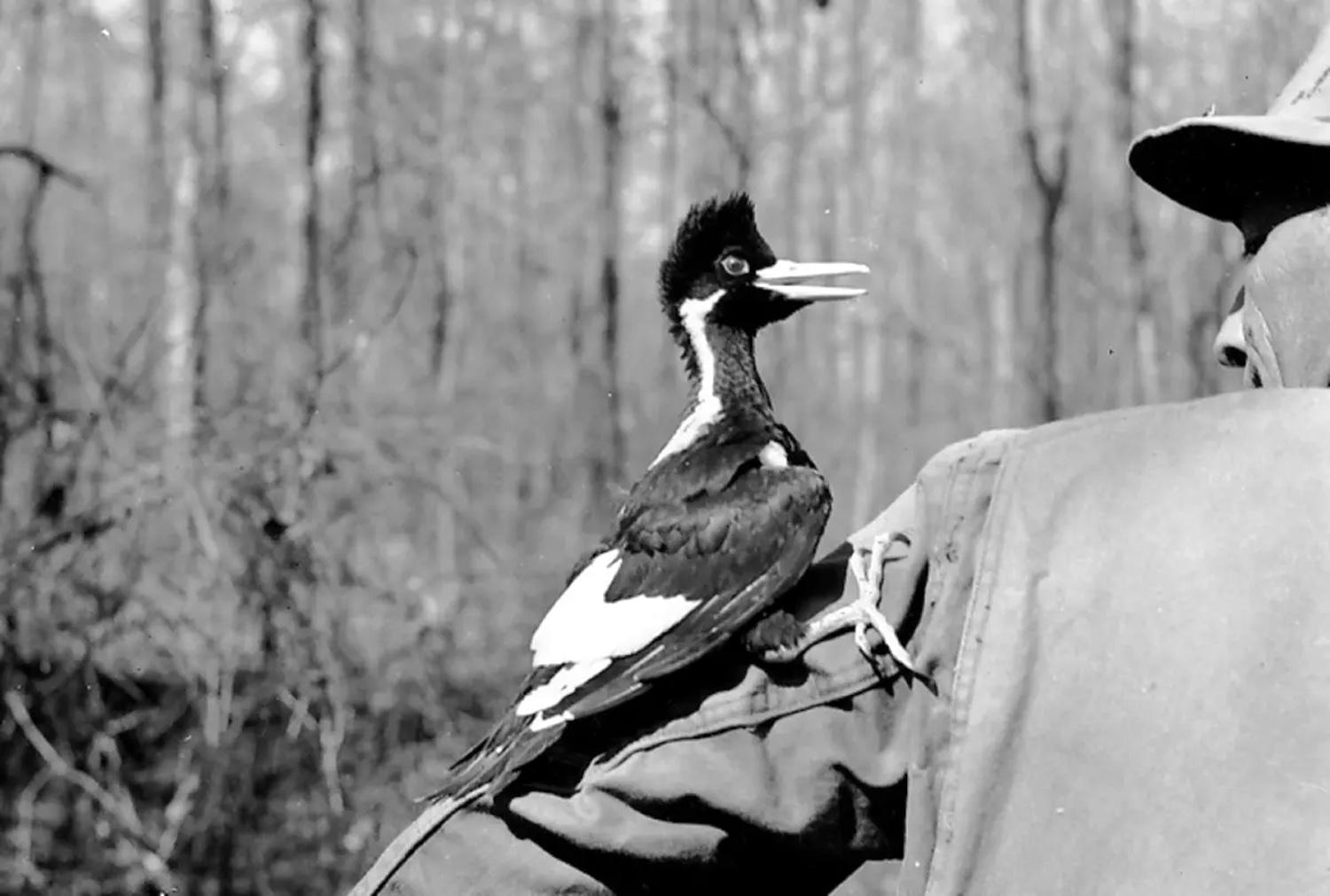
Might the Ivory-billed woodpecker still exist?/USFWS, public domain, by Dr. James T. Tanner
Twenty-One Species Officially Extinct, While The Ivory-Billed Woodpecker Might Persist
By Kurt Repanshek
From the loss of the passenger pigeon, perhaps the most lamented extinction case in the United States, to the writing off of the Kaua’i nukupu’u, a Hawaiian forest bird vanished for more than a century and just recently officially declared extinct, the disappearance of species whittles away at the country's biodiversity and attachment to nature.
The passenger pigeon, once labled North America's most abundant species of bird, was said to darken the skies with its huge flocks. But their communal nature left them easy prey for hunters, and loss of white oak forests deprived them of both nesting grounds and food.
The Kaua’i nukupu’u, a species of honeycreeper that lived on the Hawaiian island of Kauaʻi, also couldn't survive the loss of the forests it inhabitated. It hadn't been spotted since 1899, but only last month did the U.S. Fish and Wildlife Service declare it, along with 20 other species, extinct.
"It's not surprising in the sense that most of these species hadn't been seen for decades," Noah Greenwald, the endangered species director at the Center for Biological Diversity, said of the declaration for the Kaua’i nukupu’u. "And in fact, most of them were probably extinct before the Endangered Species Act was even passed [in 1973]. So it really never had a chance to save them. Because, again, they were already extinct. Because you have to prove a negative, it really takes a long time to make that final call and say something is extinct."

Though its last confirmed sighting in the wild was in 1899, the Kauaʻi nukupuʻu was only declared extinct last month/John Gerrard Keulemans (1842-1912)
Some might find it surprising that the Ivory-billed woodpecker wasn't tagged as extinct, as well. The last sighting of an Ivory-billed woodpecker in the United States that is considered authentic was in 1944. But over the decades there have been unverified claims that the bird still flies. Video footage recorded in Lousiana just a handful of years ago shows some woodpeckers flitting from tree to tree and drumming on the trunks in search of insects. But the woodpeckers in view might be a similar, more common species.
"I think [U.S. Fish and Wildlife Service] got a lot of blowback from calling it extinct. I would love to believe that it still survives, that would be great," said Greenwald. "There's not strong evidence to support that at this point. You know, there's been some photos that have been taken, but they don't really have the detail that's needed. It closely resembles pileated woodpeckers, which are a common bird, and you would need a high quality photo or video in order to show that it wasn't extinct. And that hasn't happened."
While the Endangered Species Act is said to have been very effective, with more than 95 percent of listed species still in existence, today there are more than 2,000 species — birds, fish, shellfish, reptiles, mammals, plants, insects — listed as either threatened or endangered, and more than 650 species are believed to have gone extinct, according to the Center for Biological Diversity. Driving extinctions, and species towards the ESA for its protection, are politics, human sprawl, and lack of funds. Politics that toss up roadblocks to species protection, sprawl that erased habitat, and not enough funds for agencies charged with keeping species from going extinct to adequately do their jobs.
Climate change also is contributing, as it's altering living conditions for species. The temperature of beach sands in which sea turtle eggs are laid determines sex, with warmer beaches producing more females than males; loss of sea ice is a threat to polar bears, which hunt for seals on the ice; staghorn corals are particularly vulnerable to warming oceans, and since the the 1970s have seen a population decline of about 80 percent; the Shenandoah salamander, an endangered species found only in Shenandoah National Park, needs cool, moist conditions.
A recent poll by Defenders of Wildlife shows the vast majority of Americans, regardless of political party, continues to support the Endangered Species Act as it marks its 50th anniversary this year. At the same time, the advocacy group notes that Congress "is on track to be one of the worst on record for its treatment of the ESA, with anti-wildlife members proposing some 50 legislative proposals just this year to undermine the ESA. The proposals include measures to block essential ESA protections, to delist or downlist species like the gray wolf, grizzly bear and lesser prairie-chicken that are in need of ESA protections and funding."
“These polling results only further illuminate the glaring disconnect between strong public support for the Endangered Species Act and actions of some members of Congress who seek to weaken this highly effective law in direct contrast with the interests of their constituents," said Defenders' President and CEO, Jamie Rappaport Clark.
Habitat Losses
On the recent list of extinct species, freshwater mussels comprise nearly half of the 21, with nine species officially written off. That's not terribly surprising, said Greenwald, who joined Lindsay Rosa, the vice president of conservation research and innovation at Defenders of Wildlife, on the Traveler's podcast this week.
"Freshwater species in North America are going extinct roughly 10 times what terrestrial species are going extinct," he said. "It's just a combination of factors that are leading to that. Dams, pollution, changes in stormwater runoff, invasive species. So there's just a host of threats to our freshwater ecosystems, and we just don't treat rivers the way that we should. It was really discouraging to see the Supreme Court determine that the Clean Water Act doesn't protect roughly half the wetlands and non-perennial streams in the U.S. Instead of strengthening the Clean Water Act, which is what we need to do, we need to deal with nonpoint source pollution, they substantially weakened its oversight at exactly the wrong time to be doing that."
Rosa agreed, adding that other main drivers of extinction include "over exploitation and climate change." Also complicating things is the lack of critical habitat being designated for threatened and endangered species.
While the Trump administration directed federal agencies such as the Fish and Wildlife Service to take into account economic impacts resulting from the designation of critical habitat before making such a designation, the Biden administration rescinded that directive. But much more needs to be done to help species from dying out, the Defenders official said.
"Not all species have critical habitat designated, and even those that do, some of that was pretty delayed. A lot of it comes down to resources, staff, money. All of these things to be able to list a species, to recover a species, to come up with a plan," said Rosa. "Every single piece of this puzzle that helps to keep species from the brink of extinction and with us. We need money and resources to make it happen. And the Endangered Species Act and the [agencies] charged with the implementation are pretty much starved for funding when it comes to that."
A Defenders study found that the Fish and Wildlife Service "is getting less than half of what it needs in terms of full funding to implement the Endangered Species Act as it was intended," she added. "The impact at the end of the day is not being able to get the species the full protections that they deserve."
Losses And Gains
While the Biden administration has pledged to protect 30 percent of the nation's lands and waters for biodiversity by 2030, the Fish and Wildlife Service isn't making leaps and strides in that direction, according to Greenwald.
"Lindsay is absolutely right. There's not enough money being put towards endangered species at all, given how serious the problem is, and Fish and Wildlife Service's recovery budget is roughly $75 million, which in U.S. government terms is really just pennies. Not even pennies, really," he said. "But I would say, there's been a reticence on the part of the agency to do its job. That's exemplified with critical habitat by the fact that, throughout the '80s into the early '90s, they routinely did not designate critical habitat, they always concluded that it was not prudent until they were taken to court. And the courts found that the exception had swallowed that rule. ... There's a lot of hesitancy on the part of the agency to to create controversy, and so they they want to avoid controversy, and that sometimes subsumes their mission."
Against this loss of species, new species also are being discovered. At Great Smoky Mountains National Park alone, nearly 1,100 species previously unknown to science have been discovered over the past 25 years since Discover Life in America got underway there, and nearly 11,000 species not previously known to call the park home have been discovered. Similar work needs to be tackled around the country, Rosa and Greenwald agreed.
"The more data that we have, the better," Rosa said. "I'll always encourage efforts like that, especially citizen science efforts as well, to help us understand what species are out there and where it really can help at the end of the day. Very strategic targeted efforts for conservation."
"One of the problems is we don't even know what we're losing," said Greenwald. "The U.N. and scientists from around the world have warned that we're at risk of losing more than a million species in the coming decades. And most of those species are probably a species that has never even been described. I mean, just the fact that we're still describing species in the U.S., you know, a highly settled country, that's put a fair amount of money into research, really highlights that we're just beginning to understand our world and understand its diversity."
Traveler postscript: Catch the entire discussion of extinction and the Endangered Species Act on Traveler Episode 246.

Add comment